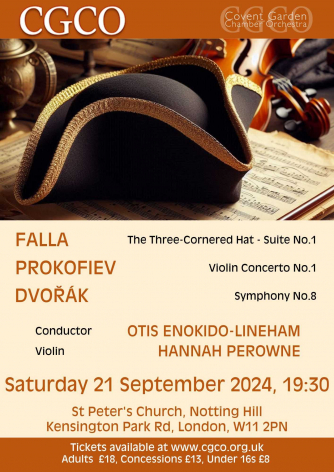Details
St Peter's Church
Kensington Park Road
Notting Hill
London
W11 2PN
England
Programme
Manuel de Falla – The Three Cornered Hat: Suite no.1
Sergey Prokofiev – Violin Concerto no.1, Op.19
~ Interval ~
Antonin Dvorak – Symphony no.8 in G major, Op.88
Performers
Otis Enokido-Lineham – Conductor
Hannah Perowne – violin
Covent Garden Chamber Orchestra
Programme Note
CGCO welcomes conductor Otis Enokido-Lineham and violinist Hannah Perowne to our 2024-25 season opener.
Falla: Suite No.1 from El Sombrero de Tres Picos
Manuel de Falla's Suite No. 1 from El Sombrero de Tres Picos is a vibrant orchestral work derived from his 1919 ballet. The suite is characterised by its lively and rhythmic Spanish folk influences, employing a variety of orchestral colours to evoke the rustic setting of the story. It features three distinct movements: "Introducción y Danza," "Danza de los Vecinos," and "Danza del Molinero," each showcasing intricate melodic lines and robust harmonies. The piece captures the essence of Andalusian culture, blending humour and passion in a vivid portrayal of village life and festivities. Falla's orchestration expertly balances percussive elements and lyrical melodies, making this suite a notable example of early 20th-century Spanish music.
Prokofiev: Violin Concerto No.1
Sergei Prokofiev's Violin Concerto No. 1 in D major stands as a significant work within the violin repertoire, reflecting the composer’s innovative spirit and lyrical prowess. Composed between 1915 and 1917, during a tumultuous period in Russian history, the concerto showcases Prokofiev's unique melodic language and structural ingenuity.
The concerto is structured in three movements:
Allegro - The first movement opens with a delicate dialogue between the solo violin and the orchestra, establishing an atmosphere of both introspection and vitality. The lyricism of the violin's themes is complemented by rhythmic vitality. The movement expands into energetic sections, exhibiting the virtuosity of the soloist while intertwining with rich orchestrations.
Andante assai - The second movement provides a contrasting sense of melancholy and serenity. Here, the violin sings with a deeply expressive line, exploring a range of emotions. The orchestral accompaniment creates a lush backdrop, enhancing the introspective quality of the violin's melodies. This movement highlights Prokofiev's ability to blend lyrical beauty with harmonic complexity.
Allegro, ben moderato - The finale bursts forth with exuberance and joy, featuring playful motifs and vibrant rhythms. The dialogue between the violin and orchestra becomes increasingly animated, culminating in a spirited conclusion that showcases the technical prowess of the soloist. This movement encapsulates Prokofiev's flair for drama and wit.
Overall, Prokofiev’s Violin Concerto No. 1 is a rich mix of emotion and technical brilliance, making it popular with both performers and audiences. Its combination of lyrical beauty and vigorous energy continues to captivate listeners.
Dvořák: Symphony No.8
Dvořák's Symphony No. 8 in G major reflects a pastoral quality, imbued with the essence of rural Bohemia, and is often regarded as one of his most uplifting works.
The symphony comprises four movements, each showcasing Dvořák's ability to blend traditional symphonic form with folk-inspired melodies. The first movement, Allegro con brio, opens with a lively theme that is both spirited and joyful. This is contrasted by more lyrical passages that display the composer's talent for creating rich orchestral textures.
In the second movement, Adagio, Dvořák presents a serene and introspective character. The gentle melodies, often carried by woodwinds, evoke a sense of introspection and tranquillity, creating a warm and reflective atmosphere.
The third movement, Scherzo (Allegretto), reintroduces the lively spirit of the opening. This section is characterised by its rhythmic vitality and playful melodies, drawing on folk dance elements that are prevalent in much of Dvořák's work. The contrasting trio section offers a delightful shift in mood, further highlighting the composer’s mastery of instrumentation.
The final movement, Allegro ma non troppo, concludes the symphony with exuberance and energy. A sense of joy and celebration permeates this movement, characterised by memorable themes and dynamic orchestration that build to an exhilarating finish.
Overall, Dvořák's Symphony No. 8 stands out as a work that encapsulates the joy of creation and the beauty of nature, making it a beloved piece in the orchestral repertoire. Its rich melodies and rhythmic vitality continue to resonate with audiences, affirming Dvořák's place as one of the great symphonic composers of the late Romantic era.

 Your events at Classical Events
Your events at Classical Events

